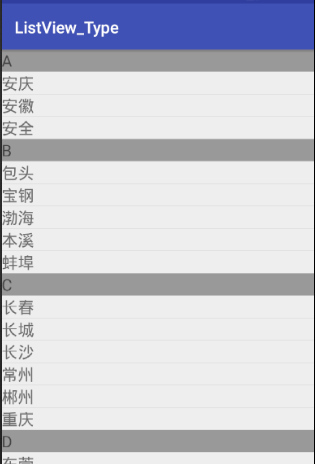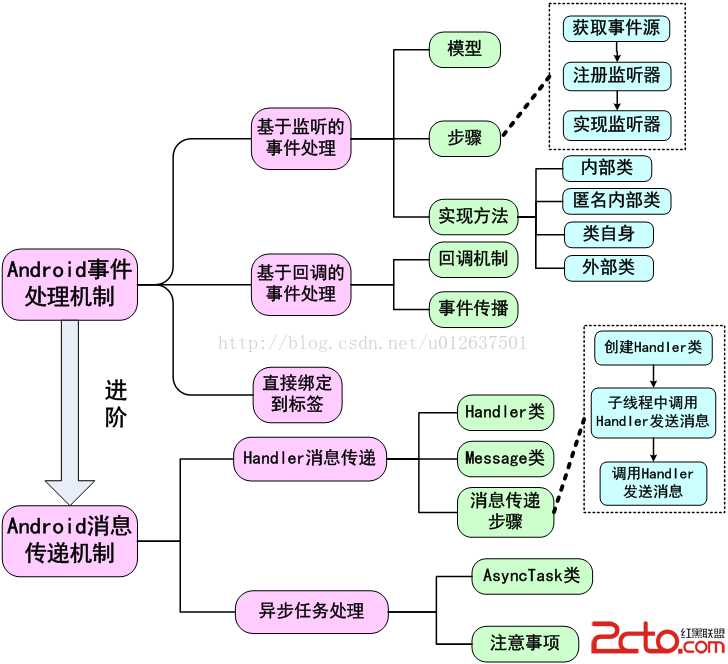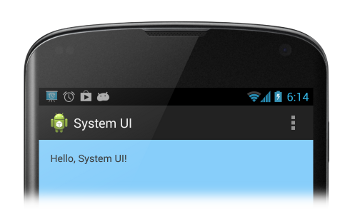編輯:關於Android編程
1.格式化價格,這個經常在計算費用精度的時候用到
/**
* 格式化價格
*
* @param argStr 傳入價格字符串
* @return
*/
public static String getFloatDotStr(String argStr) {
float arg = Float.valueOf(argStr);
DecimalFormat fnum = new DecimalFormat("##0.00");
return fnum.format(arg);
}
2.獲取App的版本號Version
// 得到versionCode
public static int getVerCode(Context context) {
int verCode = 0;
try {
verCode = context.getPackageManager().getPackageInfo(context.getPackageName(), 0).versionCode;
} catch (NameNotFoundException e) {
e.printStackTrace();
}
return verCode;
}
3.獲取手機屏幕寬高:
/**
* 屏幕寬高
*
* @param context
* @return 0:width,1:height
*/
public static int[] ScreenSize(Context context) {
DisplayMetrics metrics = new DisplayMetrics();
((WindowManager) context.getSystemService(Context.WINDOW_SERVICE)).getDefaultDisplay().getMetrics(metrics);
return new int[] { metrics.widthPixels, metrics.heightPixels };
}
4.判斷SD卡是否存在:
/**
* 判斷sd卡是否存在
*
* @author
* @return
*/
public static boolean judgeSDCard() {
String status = Environment.getExternalStorageState();
return status.equals(Environment.MEDIA_MOUNTED);
}
5.驗證是否中文:
/***
* 驗證是否中文
*
* @param
* @return
*/
public static boolean validName(String name) {
String pattern = "[\u4e00-\u9fa5]";
if (isNull(name))
return false;
return name.matches(pattern);
}
6.驗證身份證號碼:
/**
* 驗證身份證號碼
*
* @author
* @param idCard
* @return
*/
public static boolean validateIdCard(String idCard) {
if (isNull(idCard))
return false;
String pattern = "^[0-9]{17}[0-9|xX]{1}$";
return idCard.matches(pattern);
}
7.驗證手機號碼:
/**
* 驗證手機號碼
*
* @author
* @param phone
* @return
*/
public static boolean validatePhone(String phone) {
if (isNull(phone))
return false;
String pattern = "^1[3,4,5,6,8]\\d{9}$";
return phone.matches(pattern);
}
8.驗證郵編:
/**
* 判斷郵編
*
* @param
* @return
*/
public static boolean isZipNO(String zipString) {
String str = "^[1-9][0-9]{5}$";
return Pattern.compile(str).matcher(zipString).matches();
}
9.驗證銀行卡號:
/**
* 驗證銀行卡號
*
* @param bankCard
* 信用卡是16位,其他的是13-19位
* @return
*/
public static boolean validateBankCard(String bankCard) {
if (isNull(bankCard))
return false;
String pattern = "^\\d{13,19}$";
return bankCard.matches(pattern);
}
10.驗證郵箱:
/**
* 驗證郵箱
*
* @author
* @param email
* @return
*/
public static boolean validateEmail(String email) {
if (isNull(email))
return false;
String pattern = "^([a-zA-Z0-9_\\.\\-])+\\@(([a-zA-Z0-9\\-])+\\.)+([a-zA-Z0-9]{2,4})+$";
return email.matches(pattern);
}
11.將圖片設置為圓角圖片:
/**
* 設置圓角的圖片
*
* @author
* @param bitmap
* 圖片
* @param pixels
* 角度
* @return
*/
public static Bitmap toRoundCorner(Bitmap bitmap, int pixels) {
try {
if (bitmap != null) {
Bitmap output = Bitmap.createBitmap(bitmap.getWidth(), bitmap.getHeight(), Config.ARGB_8888);
Canvas canvas = new Canvas(output);
final int color = 0xff424242;
final Paint paint = new Paint();
final Rect rect = new Rect(0, 0, bitmap.getWidth(), bitmap.getHeight());
final RectF rectF = new RectF(rect);
final float roundPx = pixels;
paint.setAntiAlias(true);
canvas.drawARGB(0, 0, 0, 0);
paint.setColor(color);
canvas.drawRoundRect(rectF, roundPx, roundPx, paint);
paint.setXfermode(new PorterDuffXfermode(Mode.SRC_IN));
canvas.drawBitmap(bitmap, rect, rect, paint);
return output;
}
} catch (Exception e) {
}
return bitmap;
}
/**
* 將圖片轉換為圓形的
*
* @author
* @param bitmap
* @return
*/
public static Bitmap toRoundBitmap(Bitmap bitmap) {
if (bitmap != null) {
bitmap = cutSquareBitmap(bitmap);
return toRoundCorner(bitmap, bitmap.getWidth() / 2);
}
return bitmap;
}
12.判斷有無網絡鏈接
// 判斷有無網絡鏈接
public static boolean checkNetworkInfo(Context mContext) {
ConnectivityManager conMan = (ConnectivityManager) mContext.getSystemService(Context.CONNECTIVITY_SERVICE);
State mobile = conMan.getNetworkInfo(ConnectivityManager.TYPE_MOBILE).getState();
State wifi = conMan.getNetworkInfo(ConnectivityManager.TYPE_WIFI).getState();
if (mobile == State.CONNECTED || mobile == State.CONNECTING)
return true;
if (wifi == State.CONNECTED || wifi == State.CONNECTING)
return true;
return false;
}
13.判斷是否連接wifi
/**
* 判斷是否連接wifi
*
* @param mContext
* @return 返回true則有wifi
*/
private static boolean isWifi(Context mContext) {
ConnectivityManager connectivityManager = (ConnectivityManager) mContext.getSystemService(Context.CONNECTIVITY_SERVICE);
NetworkInfo activeNetInfo = connectivityManager.getActiveNetworkInfo();
if (activeNetInfo != null && activeNetInfo.getType() == ConnectivityManager.TYPE_WIFI) {
return true;
}
return false;
}
14.獲取SIM卡存在的狀態
/** 獲取SIM卡存在的狀態 */
public static String getSIMCardExist(Context context) {
manager = (TelephonyManager) context.getSystemService(context.TELEPHONY_SERVICE);
String state = "";
switch (manager.getSimState()) {
case TelephonyManager.SIM_STATE_READY:
state = "良好";
break;
case TelephonyManager.SIM_STATE_ABSENT:
state = "無SIM卡";
break;
default:
state = "SIM卡被鎖定或未知狀態";
break;
}
return state;
}
15. bitmap和base64類型互轉
// 把bitmap轉換成base64
public static String getBase64FromBitmap(Bitmap bitmap, int bitmapQuality) {
ByteArrayOutputStream bStream = new ByteArrayOutputStream();
bitmap.compress(CompressFormat.JPEG, bitmapQuality, bStream);
byte[] bytes = bStream.toByteArray();
return Base64.encode(bytes);
}
// 把base64轉換成bitmap
public static Bitmap getBitmapFromBase64(String string) {
byte[] bitmapArray = null;
try {
bitmapArray = Base64.decode(string);
} catch (Exception e) {
e.printStackTrace();
}
return BitmapFactory.decodeByteArray(bitmapArray, 0, bitmapArray.length);
}
16. 把圖片流轉換成byte數組
/**
*
* 方法說明 把圖片流轉換成byte數組
*
* @author
* @param
* @return
*/
public static byte[] getByteFromStream(InputStream inStream) {
byte[] data = new byte[1024];
byte[] buffer = new byte[1024];
int len = -1;
ByteArrayOutputStream outStream = new ByteArrayOutputStream();
try {
while ((len = inStream.read(buffer)) != -1) {
outStream.write(buffer, 0, len);
}
data = outStream.toByteArray();
} catch (IOException e) {
e.printStackTrace();
} finally {
try {
outStream.close();
inStream.close();
} catch (IOException e) {
e.printStackTrace();
}
}
return data;
}
17.把字節數組轉化成bitmap
/**
*
* 把字節數組轉化成bitmap
*
* @author
* @param
* @return
*/
public static Bitmap getBitmapFromBytes(byte[] bytes, BitmapFactory.Options opts) {
if (bytes != null)
if (opts != null)
return BitmapFactory.decodeByteArray(bytes, 0, bytes.length, opts);
else
return BitmapFactory.decodeByteArray(bytes, 0, bytes.length);
return null;
}
18.把Stream轉換成String
// 把Stream轉換成String
public static String convertStreamToString(InputStream is) {
BufferedReader reader = new BufferedReader(new InputStreamReader(is));
StringBuilder sb = new StringBuilder();
String line = null;
try {
while ((line = reader.readLine()) != null) {
sb.append(line + "/n");
}
} catch (IOException e) {
e.printStackTrace();
} finally {
try {
is.close();
} catch (IOException e) {
e.printStackTrace();
}
}
return sb.toString();
}
19.防止按鈕連續點擊
/**
* 防止按鈕連續點擊
*/
private static long lastClickTime;
public static boolean isFastDoubleClick() {
long time = System.currentTimeMillis();
long timeD = time - lastClickTime;
if (0 < timeD && timeD < 500) {
return true;
}
lastClickTime = time;
return false;
}
20.保存圖片到SD卡
/**
* 保存圖片
*
* @param photoBitmap
* @param path 保存路徑
*/
public static void savePhotoToSDCard(Bitmap photoBitmap, String path) {
File photoFile = new File(path);
FileOutputStream fileOutputStream = null;
try {
fileOutputStream = new FileOutputStream(photoFile);
if (photoBitmap != null) {
if (photoBitmap.compress(Bitmap.CompressFormat.JPEG, 70, fileOutputStream)) {
fileOutputStream.flush();
}
}
} catch (FileNotFoundException e) {
photoFile.delete();
e.printStackTrace();
} catch (IOException e) {
photoFile.delete();
e.printStackTrace();
} finally {
try {
fileOutputStream.close();
} catch (IOException e) {
e.printStackTrace();
}
}
}
21.將字符串轉化為二維碼:
private static int QR_WIDTH = 300;
private static int QR_HEIGHT = 300;
public static Bitmap createQRImage(String url) {
try {
// 判斷URL合法性
if (url == null || "".equals(url) || url.length() < 1) {
return null;
}
Hashtable hints = new Hashtable();
hints.put(EncodeHintType.CHARACTER_SET, "utf-8");
// 圖像數據轉換,使用了矩陣轉換
BitMatrix bitMatrix = new QRCodeWriter().encode(url, BarcodeFormat.QR_CODE, QR_WIDTH, QR_HEIGHT);
int[] pixels = new int[QR_WIDTH * QR_HEIGHT];
// 下面這裡按照二維碼的算法,逐個生成二維碼的圖片,
// 兩個for循環是圖片橫列掃描的結果
for (int y = 0; y < QR_HEIGHT; y++) {
for (int x = 0; x < QR_WIDTH; x++) {
if (bitMatrix.get(x, y)) {
pixels[y * QR_WIDTH + x] = 0xff000000;
} else {
pixels[y * QR_WIDTH + x] = 0xffffffff;
}
}
}
// 生成二維碼圖片的格式,使用ARGB_8888
Bitmap bitmap = Bitmap.createBitmap(QR_WIDTH, QR_HEIGHT, Bitmap.Config.ARGB_8888);
bitmap.setPixels(pixels, 0, QR_WIDTH, 0, 0, QR_WIDTH, QR_HEIGHT);
return bitmap;
} catch (Exception e) {
e.printStackTrace();
}
return null;
}
22.得到自定義進度框:
/**
* 得到自定義的progressDialog
*
* @param context
* @param msg
* @param bCancel
* 按返回鍵是否取消
* @return
*/
public static Dialog createLoadingDialog(Context context, String msg, boolean bCancel) {
LayoutInflater inflater = LayoutInflater.from(context);
View v = inflater.inflate(R.layout.loading_dialog, null);// 得到加載view
LinearLayout layout = (LinearLayout) v.findViewById(R.id.dialog_view);// 加載布局
// main.xml中的ImageView
ImageView spaceshipImage = (ImageView) v.findViewById(R.id.img);
TextView tipTextView = (TextView) v.findViewById(R.id.tipTextView);// 提示文字
// 加載動畫
Animation hyperspaceJumpAnimation = AnimationUtils.loadAnimation(context, R.anim.loading_animation);
// 使用ImageView顯示動畫
spaceshipImage.startAnimation(hyperspaceJumpAnimation);
tipTextView.setText(msg);// 設置加載信息
Dialog loadingDialog = new Dialog(context, R.style.loading_dialog);// 創建自定義樣式dialog
loadingDialog.setCancelable(bCancel);// 不可以用“返回鍵”取消
loadingDialog.setCanceledOnTouchOutside(false);
loadingDialog.setContentView(layout, new LinearLayout.LayoutParams(LinearLayout.LayoutParams.MATCH_PARENT, LinearLayout.LayoutParams.MATCH_PARENT));// 設置布局
return loadingDialog;
}
 Android(Lollipop/5.0) Material Design(一) 簡介
Android(Lollipop/5.0) Material Design(一) 簡介
使用Material Design 需要api21,即Lollipop/5.0以上 Material Design 為應用提供了:一個新的主題,一些組合Vi
 詳解ListView中多種item的實現方式
詳解ListView中多種item的實現方式
大家都知道在實際開發時,對ListView的使用比較頻繁,其表現也非常復雜。本文將通過實例介紹ListView中多種item的實現方式,下面來一起看看吧。使用ListVi
 Android筆記Android基於事件監聽器處理機制
Android筆記Android基於事件監聽器處理機制
一、Android的事件處理 Android事件處理包括兩個部分:Android事件處理機制(基本)和Android消息傳遞機制(進階)。前者包含三種處理方式
 Android官方開發文檔Training系列課程中文版:管理系統UI之隱藏狀態條
Android官方開發文檔Training系列課程中文版:管理系統UI之隱藏狀態條
這節課將會介紹如何隱藏不同的版本的狀態條。隱藏狀態條可以使內容展示區域更大,因此可以提供一種更強的身臨其境的用戶體驗。含有狀態條的APP:隱藏狀態條的APP,注意這裡的A